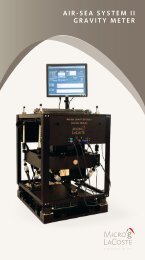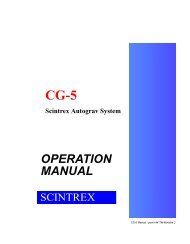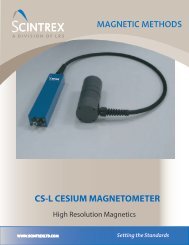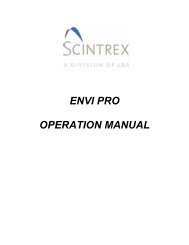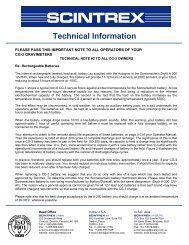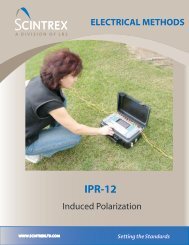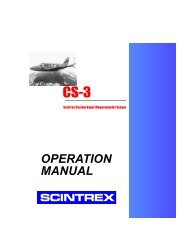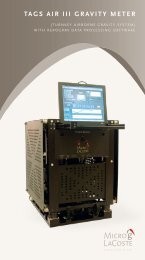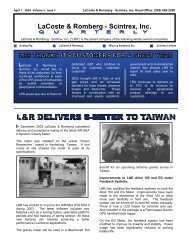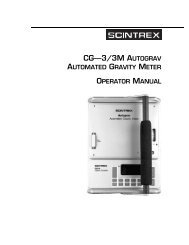CG-3 Description & Test Results - Scintrex
CG-3 Description & Test Results - Scintrex
CG-3 Description & Test Results - Scintrex
You also want an ePaper? Increase the reach of your titles
YUMPU automatically turns print PDFs into web optimized ePapers that Google loves.
IntroductionCommercially available gravity meters for use on land in the post World War II period have beendominated by two designs: the Worden type of quartz instrument, and the Lacoste and Romberg, with ametal sensor. Both of these were developed to operate without the use of electronics. They rely on thezero length spring concept developed by Lacoste (1934) to obtain high mechanical sensitivity to gravitychanges (astatisation) and to reduce the effect of seismic noise.Although the accuracy of these instruments is adequate for their intended applications, they have severaldeficiencies both from an operational and a manufacturing viewpoint.In normal field use with both instrument types, the operator is required tonull the sensor beam manually by rotating a micrometer screw and then record the reading manually.There are several possible sources of error in this process and a high level of operator skill andexperience is required. Entering thedata into a computer for processing is time consuming and is a further source of potential error.The manufacturing difficulties are significant. Achieving astatisation requires a finely balancedmechanism. Mechanical feedback systems require more precision mechanisms. They also incorporatemechanical feedthroughs into the chamber containing the sensing element, leading to pressuresensitivity problems. Solutions to these further increase the complexity of the system.As well, the adjustments required to effect mechanical temperature compensation in quartz instrumentsdemands an extremely high level of craftsmanship. In the Lacoste and Romberg instruments the problemis reduced by using low temperature coefficient alloys. These however are sensitive to magnetic fieldvariations, making it necessary to shield the sensor.Against this background, <strong>Scintrex</strong> started the development four years ago of a new gravity meter, the<strong>CG</strong>3. The goals of the project were to overcome the operational deficiencies of existing instruments,and to produce a design that was mechanically simple enough to be manufactured on a routineproduction basis, on the assumption that the electronic advances of the thirty to forty years since theinitial development of the Worden and Lacoste instruments could be utilized to achieve these goals.The more specific technological base for the development was the recent introduction of the <strong>Scintrex</strong>IGS general purpose field portable data acquisition/control system; and current developments in theapplication of capacitive displacement transducers and electrostatic feedback to gravity meters (Hugill1984).An instrument conforming to these requirements has successfully been developed, and is presently in thefinal testing stages. This paper describes the <strong>CG</strong>3 gravity meter and its performance in laboratory andfield tests.2



